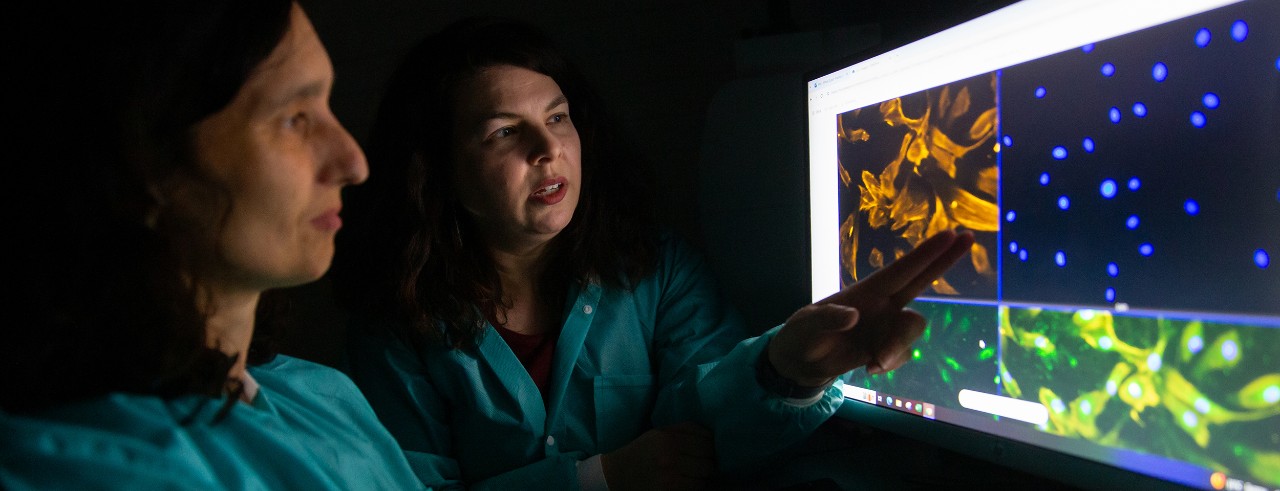
UC examines how painful fibroids grow
Researchers find ways that cells respond differently to strain
Insights into how uterine tumors grow could give hope to millions of women who deal with painful fibroids.
Nearly 8 in 10 women develop fibroids, noncancerous tumors that develop in the uterus during child-bearing years. They can be extremely painful, cause extensive bleeding and lead to infertility.
Researchers at the University of Cincinnati found different signaling pathways being used by the fibroid cells compared to the uterine cells.
“That’s important for identifying therapeutic targets because we want to target the tumor without affecting the surrounding tissue,” said Stacey Schutte, an assistant professor of biomedical engineering in UC’s College of Engineering and Applied Science.
The study was published in the journal F&S Science.

Assistant Professor Stacey Schutte, left, and Research Associate Andreja Moset Zupan study new avenues to treat fibroids in Schutte's biomedical engineering lab in UC's Bioscience Center. Photo/Andrew Higley/UC Marketing + Brand
Treating fibroids is often invasive and expensive, costing patients and their insurers billions of dollars each year, according to the National Institutes of Health. Treatments can often lead to infertility as well, Schutte said.
“One in nine women will have a hysterectomy in their lifetime. And one-third to one-half of those are [because of] uterine fibroids,” Schutte said.
Schutte has experience in this research field. She was a postdoctoral fellow at the Emory University School of Medicine’s Department of Gynecology and Obstetrics.
“It usually isn’t life-threatening, but the pain can be immense,” she said. “Contractions push the tumors into the muscle tissue.”
During each menstrual cycle, the body releases estrogen and progesterone, which causes the tissue lining inside the uterus to thicken in anticipation of possible pregnancy. These hormones also help fibroids grow.
But Schutte said cells likewise can react to physical strain — like a defense mechanism to protect the cells.
“I came from working in cardiovascular medicine. We studied mechanical strain on blood vessels. Mechanical forces can cause cells to produce a lot of extracellular matrix to increase the size of the tissue,” she said.
I want to find ways to affect fibroids but not the surrounding muscle cells.
Stacey Schutte, UC Assistant Professor of Biomedical Engineering
UC researchers grew fibroid cells and uterine cells on plates with an elastic bottom. Then they used a device to expose the cells to mechanical strain to mimic the environment that fibroids encounter in the uterus.
“We have a flexible tension device. We grew cells on plates with an elastic bottom. Then we used a vacuum to pull and stretch it,” Schutte said. “It stretches cells in a single direction.”
“We found that fibroid cells were more sensitive to strain,” said study lead author Rachel Warwar, MD, in UC’s College of Medicine.
Warwar said they identified differences in the ways the cells held their shape.
Warwar works in UC’s Department of Obstetrics and Gynecology. She said the findings highlight the importance of incorporating not just hormones but mechanical strain into the study of fibroid cells.
“The more we are able to mimic the environment of these cells in the uterus, the more we will understand the pathology of these cells and can then work to target anomalous pathways in fibroid cells,” she said.

Assistant Professor Stacey Schutte's biomedical engineering lab in UC's Bioscience Center collaborates with researchers in the UC College of Medicine. Photo/Andrew Higley/UC Marketing + Brand
Nearly 4 in 5 women have fibroids during their lifetimes. Because they are so common, they represent a major health care cost — as much as $9 billion per year in the United States.
Common noninvasive treatments target hormones responsible for fibroid growth.
“We are looking for nonhormonal treatments for fibroids,” said study coauthor Andreja Moset Zupan, a research associate in Schutte’s biomedical engineering lab.
“It’s another option we could use to preserve the fertility of women who still want to get pregnant,” she said.
Once researchers understand the cell pathology, Warwar said, they can study fibroids using 3D simulations and modeling, which could help them further understand how fibroids develop and the best ways to treat them.
“I want to find ways to affect fibroids but not the surrounding muscle cells,” Schutte said. “There is at least one pathway, if not more, that responds differently.”
Schutte said the next step is to create more complex tissue models to mimic tumor growth to learn ways to inhibit it.
“It makes me really happy to think we can find a target.”
Featured image at top: Assistant Professor Stacey Schutte, right, and Research Associate Andreja Moset Zupan are looking for new treatments for fibroids in Schutte's biomedical engineering lab in UC's Bioscience Center. Photo/Andrew Higley/UC Marketing + Brand
Next Lives Here
The University of Cincinnati is leading public urban universities into a new era of innovation and impact. Our faculty, staff and students are saving lives, changing outcomes and bending the future in our city's direction. Next Lives Here.
Related Stories
UC examines how painful fibroids grow
December 21, 2023
Insights into how uterine tumors grow could give hope to millions of women who deal with painful fibroids.
President picks exceptional talent
April 28, 2021
The University of Cincinnati 2021 Presidential Leadership Medal of Excellence Awards honor six undergraduate scholars for scholarship, leadership, character, service and the ideals of the university. Awardees are spotlighted for exceptional academics, creativity, community service and innovation.
UC joins Ohio to improve worker safety
September 9, 2024
Ohio is taking steps to ensure the safety of workers in proximity to these electronic tools. The Bureau of Workers’ Compensation awarded $9.4 million for workforce safety innovation projects, including two led by UC’s College of Engineering and Applied Science.
